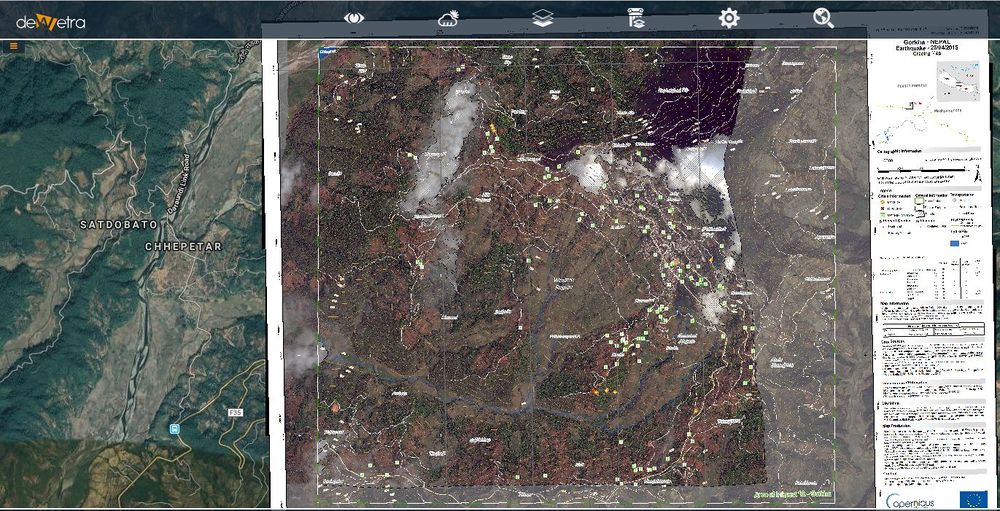Difference between revisions of "EMS layers(eng)"
| Line 17: | Line 17: | ||
|- | |- | ||
|Description | |Description | ||
| − | | | + | |EMS - Rapid Mapping products<br> |
| − | + | This service consists of the on-demand and fast provision (hours-days) of geospatial information. This information supports emergency management activities immediately following an emergency event. The service is based on the acquisition, processing and analysis, in rapid mode, of satellite imagery and other geospatial raster and vector data sources. The products are standardised following a set of parameters the user can choose when requesting the service. The user can choose between three different map types (Reference, Delineation, Grading) and two prodution modes (service levels). The maps can be requested individually (i.e. Delineation map only) or in combination with other map types (i.e. Delineation and Grading). Maps can be requested in service level 1 (SL1) or service level 5 (SL5). In the case of service level 1 (SL1), maps are provided within some hours after delivery and quality approval of imagery (9h for Reference maps, 12h for Delineation and Grading maps). For service level 5 (SL5), all map types are typically provided within five working days (SL5) (the delivery time of SL5 can be adapted to user needs). Updates of the initial map may be requested as Monitoring maps. | |
| − | + | The product delivery package of Rapid Mapping contains a series of ready to print maps with different resolutions and formats and a vector data package. The Product User Manual gives a detailed overview of the product characteristics and of the vector package in particular. <br> | |
| − | + | ||
| + | <u>Reference maps</u> provide a quick updated knowledge on the territory and assets using data prior to the disaster. The content consists of selected topographic features on the affected area, in particular exposed assets and other available information that can assist the users in their specific crisis management tasks. A reference map is normally based on a pre-event image captured as close as possible prior to the event.<br> | ||
| + | |||
| + | <u>Delineation maps</u> provide an assessment of the event extent (and of its evolution if requested). Delineation maps are derived from satellite post-disaster images. They vary depending on the disaster type and the delineation of the areas impacted by the disaster.<br> | ||
| + | |||
| + | <u>Grading maps</u> provide an assessment of the damage grade (and of its evolution if requested). Grading maps are derived from post-event satellite images. Grading maps include the extent, magnitude or damage grades specific to each disaster type. They may also provide relevant and up-to-date information that is specific to affected population and assets, e.g. settlements, transport networks, industry and utilities.<br> | ||
| − | |||
| − | |||
| − | |||
More info at: [https://emergency.copernicus.eu/ Emergency Management Service - Copernicus] | More info at: [https://emergency.copernicus.eu/ Emergency Management Service - Copernicus] | ||
| Line 30: | Line 32: | ||
|- | |- | ||
|Screenshot | |Screenshot | ||
| − | |[[File: | + | |[[File:all_emsr.JPG|1000px|thumb|centre|]] |
|} | |} | ||
Revision as of 23:15, 16 November 2018
| Layer name | EMS Copernicus - layers |
| Tag | Floods/Earthquakes |
| Folder | |
| Source | Emergency Management Service - Copernicus |
| Description | EMS - Rapid Mapping products This service consists of the on-demand and fast provision (hours-days) of geospatial information. This information supports emergency management activities immediately following an emergency event. The service is based on the acquisition, processing and analysis, in rapid mode, of satellite imagery and other geospatial raster and vector data sources. The products are standardised following a set of parameters the user can choose when requesting the service. The user can choose between three different map types (Reference, Delineation, Grading) and two prodution modes (service levels). The maps can be requested individually (i.e. Delineation map only) or in combination with other map types (i.e. Delineation and Grading). Maps can be requested in service level 1 (SL1) or service level 5 (SL5). In the case of service level 1 (SL1), maps are provided within some hours after delivery and quality approval of imagery (9h for Reference maps, 12h for Delineation and Grading maps). For service level 5 (SL5), all map types are typically provided within five working days (SL5) (the delivery time of SL5 can be adapted to user needs). Updates of the initial map may be requested as Monitoring maps.
The product delivery package of Rapid Mapping contains a series of ready to print maps with different resolutions and formats and a vector data package. The Product User Manual gives a detailed overview of the product characteristics and of the vector package in particular. Reference maps provide a quick updated knowledge on the territory and assets using data prior to the disaster. The content consists of selected topographic features on the affected area, in particular exposed assets and other available information that can assist the users in their specific crisis management tasks. A reference map is normally based on a pre-event image captured as close as possible prior to the event. Delineation maps provide an assessment of the event extent (and of its evolution if requested). Delineation maps are derived from satellite post-disaster images. They vary depending on the disaster type and the delineation of the areas impacted by the disaster. Grading maps provide an assessment of the damage grade (and of its evolution if requested). Grading maps are derived from post-event satellite images. Grading maps include the extent, magnitude or damage grades specific to each disaster type. They may also provide relevant and up-to-date information that is specific to affected population and assets, e.g. settlements, transport networks, industry and utilities.
|
| Screenshot |
